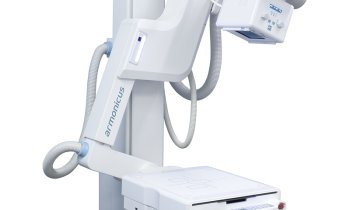Sponsored • Modern cementing technology
Cemented hips help preventing infections
For decades, hip arthroplasty has been a routine procedure. In Europe, both total and partial hip replacements are the most frequent surgical interventions for patients with hip fracture or osteoarthritis. The treatment relieves pain and has good long-term outcomes. In cemented hip replacement, the artificial acetabulum and/or the femoral stem are fixed with bone cement and implant and bone bond immediately.
To prevent infections, the cement contains one or two antibiotics. Comprehensive studies have confirmed many benefits of this method.
The trend towards uncemented implants

Nevertheless, in Denmark, currently around 70 % of the patients receive uncemented implants, whereas Norway and Sweden are more conservative, but the use of uncemented implants has increased even in these countries, in Sweden from 3% in 2000 to 28% in 2019.
According to the German Arthroplasty Registry’s (EPRD) annual report 2019, in Germany, the number of cemented total hip replacements decreased from 8 % to 5 % between 2014 and 2018 across all patient age groups; at the same time, the percentage of entirely cement-free replacements increased from 75 % to 79 %. ‘Comprehensive studies have confirmed the many advantages of cemented hip replacements, such as a reduced fracture risk. Particularly certain patient groups, above all older patients or patients with hip fractures, profit from this type of implant.
‘However, in many countries, clinical practice does not follow scientific evidence,’ says Professor of orthopaedic surgery Søren Overgaard of Copenhagen University Hospital, Bispebjerg, Denmark. The reasons for this trend, he assumes, might be the fact that surgeons are not familiar with the current evidence and the differences in training and culture in healthcare systems.
A sustainable bonding solution
The goals of any surgical intervention are pain reduction, maintaining long-term function and avoiding complications and revision surgery. The outcome is shaped by several factors – which can be partially controlled by the surgeon and the patients. ‘Advanced patient age is a given,’ says Overgaard. But ‘consumption of tobacco, alcohol or medication and the willingness to undergo surgery are issues that patient and physician can discuss.’
In addition to patient selection, perioperative care and rehab, the choice of bonding components plays a crucial role. This decision should always be based on reliable data. ‘There is plenty of evidence from high-quality studies,’ says Overgaard and adds that his team ‘chooses the individual suitable fixing methods based on this evidence.’ The high percentage of uncemented implants shows that this is not best practice in all hospitals. Overgaard underlines a lack of experience particularly among young physicians. ‘We surgeons only teach what we can do,’ he says, but ‘the objective should be to decide on the basis of reliable evidence in order to achieve best outcomes for the patient and reduce complications.’
Periprosthetic fracture is more common in uncemented stem fixation

The most common complications after hip replacement are loosening of the components, infection, periprosthetic fracture, and dislocation. Among these complications, periprosthetic fracture (PPF) had the highest mortality, according to the Swedish Arthroplasty Register. ‘Thus, prevention of a PPF not only can increase the quality of life, but also might save lives,’ concludes Dr Georgios Chatziagorou from the University of Gothenburg in Sweden.
‘It’s therefore, important to identify the patients most at risk of PPF,’ he emphasises. Increasing age is a known risk factor, and uncemented femoral components resulted in higher risk of revision surgery, according to a large register study. Among male patients aged 60-69 years who received an uncemented stem, the risk of PPF was four times as high as among the same age group with cemented stem. However, among women of the same age-group, the risk was thirteen times higher for those with uncemented stem fixation compared to women with a cemented femoral component.
Women older than 55 years should receive cemented hip replacements, according to data from the Norwegian Arthroplasty Register. A Danish study showed positive effects of changing from uncemented to cemented fixation.
The number of periprosthetic fracturea decreased from 4.1% to 2% when the number of women above 60 receiving cemented hip replacements increased from 12.3 % to 82.5 % during the same period of time.
Hip fracture patients are particularly at risk due to comorbidities

For Nils Hailer, Professor of orthopaedics at Uppsala University Hospital in Sweden, older patients who receive a partial or total hip replacement following a femoral neck fracture are a high-risk group due to their comorbidities and high early mortality. Despite the risk of bone cement implantation syndrome, he recommends cemented implants for this group since the benefits of cemented fixation vastly outweigh the disadvantages. ‘Uncemented hemiarthroplasty patients require second surgery twice as often as other patients,’ because ‘the risk of PPF and infections is increased, and the life span of the implant is decreased.’ Moreover, patients with a cemented hip replacement regain mobility much faster.
In addition, the infection risk can be reduced with a cemented hip, Hailer points out: ‘We have solid evidence that infection protection is achieved when we use cements loaded with antibiotics. There is also emerging evidence that dual antibiotic cement can further reduce the risk of periprosthetic joint infection in hip fracture patients, but several ongoing randomised trials need to confirm this theory.’
A randomised controlled study conducted in Newcastle confirms this view: The use of high dose dual-antibiotic impregnated cement in these patients reduced the infection rate by 69 % compared with standard low dose single antibiotic loaded bone cement. Thus, Hailer concludes, ‘Un- cemented hemiarthroplasty should by all means be avoided in patients with hip fractures, both to reduce the risk of periprosthetic fracture and infection.’
The experts agree that evidence-based treatment decisions would significantly improve outcomes. In view of the study results and the fact that, in Denmark, 50 % of the hip fracture patients receive uncemented hemiarthroplasty, Professor Overgaard has and aims for a clear goal: ‘We will try to change that.’
Scientific references available on request.
30.09.2021











